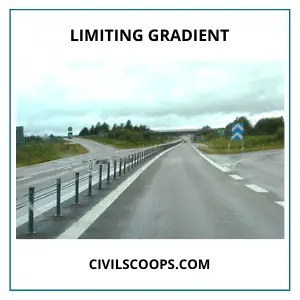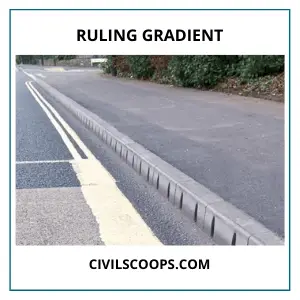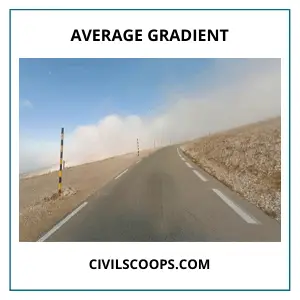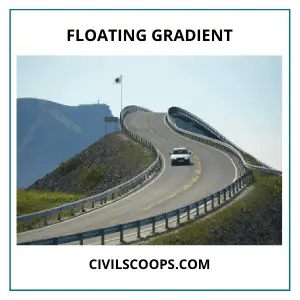What Is Gradient of Road? | Limiting Gradient of Road | Types of Gradient of Road | Exceptional Gradient of Road | The Gradient of Road | Purpose of Providing Gradient of Road | Importance of Gradient in Roads
Table of Contents
What Is Gradient of Road?
The gradient is the rise and fall of the gradient with respect to the horizontal line. Gradients are mainly four types those are-
- Ruling gradient: This type of gradient is the maximum gradient that is provided on the highway. It is also termed the designer gradient. Ruling gradient depends on terrain length, speed, power of the vehicle, etc. The ruling gradient in hilly terrain is difficult to provide.
- Exceptional gradient: This type of gradient is a very exceptional gradient, and it’s a very steeper gradient. The length of this gradient should not be less than 100m.
- Limiting gradient: Limiting gradient is provided in shorter stretches on the highway. When the limiting gradient is costlier, then we provide a limiting gradient.
- Minimum gradient: For drainage purposes of rainwater, the minimum gradient is required. For concrete drain 1 in 500 slopes is provided, and soil drain 1 in 200 slopes is required.
Limiting Gradient of Road
- A limiting gradient is the type of gradient which is steeper than the ruling gradient.
- This gradient is used for a limited portion of the road.
- The ruling gradient is used where we need a steeper slope than the ruling gradient and it’s also very low of cost to construct.
Types of Gradient of Road
Gradients are mainly categorized into six categories, those are-
1. Limiting Gradient of Road

Limiting gradient is that type of gradient which is steeper than the ruling gradient. This limiting gradient is mainly used in rolling terrain and hilly terrain. This gradient is also known as a maximum gradient.
2. Ruling Gradient of Road

The ruling gradient is that type of gradient which is used to make the alignment of the road. This is adopting widely because this gives maximum safety at minimum cost.
3. Exceptional Gradient of Road

Exceptional Gradient is that type of gradient which is steeper than limiting gradient, this is used only for special situations. This gradient is adopted in an unavoidable situation like mountainous terrain that’s why the gradient is steeper ad it causes more fuel requirement and frictional losses.
4. Average Gradient of Road

The rate of fall or rise between two points along the road alignment is known as an average gradient.
5. Floating Gradient of Road

The floating gradient is a gradient where vehicles are moving smoothly with constant speed without using braking or other application.
6. Minimum Gradient of Road

The minimum gradient is that type of gradient where we provide a minimum slope for drainage purposes of rainwater.
Exceptional Gradient of Road
- Exceptional Gradient is that type of gradient which is steeper than limiting gradient.
- Exceptional Gradient is used only for special situations.
- Exceptional Gradient is used when the roads with shorter lengths are available.
- This gradient is adopted in unavoidable situations like mountainous terrain.
- The exceptional gradient is very steeper thus it causes more fuel requirement and frictional losses.
The Gradient of Road
- The gradient of the road is that where the rate of rising and fall of the road is measured with respect to the horizontal.
- It is also known as the longitudinal slope for the formation of the level of the road along its alignment.
Purpose of Providing Gradient of Road
- This is mainly provided to clear out the drainage purpose of rainwater.
- It mainly connects the two points at different levels.
- It is mainly provided to construct the side drains properly.
- By cutting filling operation the earthwork for road construction is economical.
Importance of Gradient in Roads
- The most important part of roads is the gradient.
- The movements of motor vehicles smoothly due to the gradient.
- The gradient is mainly provided to construct the side drains properly.
- At first the vehicular cost, construction cost is measured then we choose what kind of gradient is to be used.
[note note_color=”#F2F2F2 ” text_color=”#333333″ radius=”3″ class=”” id=””]
Like this post? Share it with your friends!
Suggested Read –
- What Is Lap Length? | Lap Length in Beam | Why Lapping Is Provided? | How to Calculate Lap Length? | Lap Length as Per Is Code 456 | What Are the General Rules for Lap Length? | Lapping Zone
- Hollow Block | Hollow Concrete Block | Hollow Concrete Block Size |Hollow Concrete Block Advantage | Hollow Concrete Block Disadvantage | Hollow Concrete Wall | Hollow Block Construction | Size of Hollow Blocks | How to Make Hollow Blocks
- Hand Level Surveying | What Is Site Level? | What Is Hand Level? | How to Use a Hand Sight Level | Estimating Distances with a Sight Level
- Types of Cement Grades | Difference Between 33, 43 &53 Grade Cement
- What Is Panelled Window? | What Is Glazed Window? | Difference Between Paneled Window and Glazed Window
[/note]
Originally posted 2021-09-08 13:20:44.

